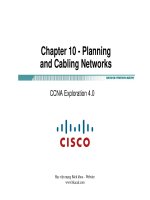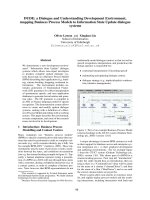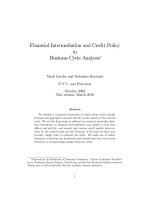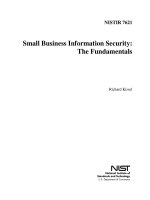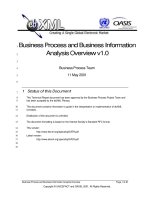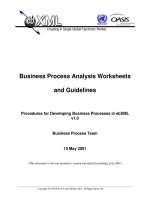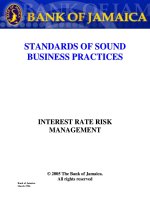Business Process and Business Information: Analysis Overview v1.0 ppt
Bạn đang xem bản rút gọn của tài liệu. Xem và tải ngay bản đầy đủ của tài liệu tại đây (230.42 KB, 40 trang )
Business Process and Business Information
2
Analysis Overview v1.0
1
3
4
Business Process Team
5
11 May 2001
6
7
8
9
1 Status of this Document
This Technical Report document has been approved by the Business Process Project Team and
has been accepted by the ebXML Plenary.
10
11
This document contains information to guide in the interpretation or implementation of ebXML
concepts.
12
Distribution of this document is unlimited.
13
The document formatting is based on the Internet Society’s Standard RFC format.
14
This version:
15
16
17
/>Latest version:
/>
18
19
Business Process and Business Information Analysis Overview
Copyright © UN/CEFACT and OASIS, 2001. All Rights Reserved.
Page 1 of 40
ebXML BP/CC Analysis Team
20
21
March 2001
2 ebXML Business Process Analysis Participants
Business Process Project Team Co-Leads
22
Paul Levine, Telcordia
23
Marcia McLure, McLure-Moynihan, Inc.
24
25
We would like to recognize the following for their significant participation to the development of this
document.
26
Editors:
27
28
29
Randy Clark, Baker Hughes, Inc
Brian Hayes, Commerce One
Contributors:
30
James Bryce Clark, Spolin Silverman & Cohen LLP
31
Jim Clark, I.C.O.T.
32
Charles Fineman, Arzoon.com
33
Bob Haugen, Logistical Software LLC
34
Stephan de Jong, Philips International B.V.
35
Larissa Leybovich, Vitria Technology
36
Paul Levine, Telcordia
37
Bill McCarthy, Michigan State University
38
Marcia McLure, McLure-Moynihan, Inc.
39
Karsten Riemer, Sun Microsystems
40
Nita Sharma, IONA Technologies
41
David Welsh, Nordstrom.com
Business Process and Business Information Analysis Overview
Copyright © UN/CEFACT and OASIS, 2001. All Rights Reserved.
Page 2 of 40
ebXML BP/CC Analysis Team
42
March 2001
3 Table of Contents
43
1 Status of this Document............................................................................................. 1
44
2 ebXML Participants.................................................................................................... 2
45
3 Table of Contents....................................................................................................... 3
46
4 Introduction............................................................................................................... 4
47
4.1
Summary........................................................................................................... 4
48
4.2
Scope and Audience........................................................................................... 4
49
4.3
Related Documents............................................................................................. 5
50
4.4
Document Conventions........................................................................................ 5
51
5 Goal and Objectives................................................................................................... 7
52
5.1
Goal.................................................................................................................. 7
53
5.2
Objectives .......................................................................................................... 7
54
5.3
Caveats and Assumptions .................................................................................... 7
55
6 Business Collaboration Overview............................................................................... 8
56
6.1
ebXML Electronic Business Collaboration............................................................... 8
57
6.2
Economic Elements in Business Processes.......................................................... 10
58
6.3
ebXML Design Time and Runtime Reference Model .............................................. 13
59
7 Business Process and Information Modeling............................................................ 15
60
7.1
Overview ......................................................................................................... 15
61
7.2
Business Process and Information Meta Model ..................................................... 15
62
8 The Analysis Process .............................................................................................. 16
63
8.1
Introduction...................................................................................................... 18
64
8.2
Recommended Business Process and Business Information Analysis Methodology
and Meta Model……………………………………………………………………………..18
65
66
67
68
8.3
Business Processes and Business Documents.................................................... 188
8.4
The Analysis Process........................................................................................ 22
9 Relationship Between Business Process and Core Components .............................. 28
69
9.1
Introduction...................................................................................................... 28
70
9.2
Business Library and Business Information Objects ............................................... 28
71
9.3
Core Components Analysis................................................................................ 30
72
9.4
Core Component Contextual Classification........................................................... 30
73
9.5
Context and Common Business Processes .......................................................... 31
74
10 Analysis Aids: Worksheets and Tools ...................................................................... 32
75
10.1 Analysis Worksheets and Guidelines ................................................................... 32
76
10.1.1 Analysis Worksheets and Editor…………………………………………………..32
77
10.1.2 Business Process Editor and Document Editor………………………………….33
78
11 References…………………………………………………………………………………………34
79
12 Disclaimer............................................................................................................... 35
80
13 Contact Information................................................................................................. 35
81
Appendix A: Context Category-Meta Model Cross-Refere nce......................................... 36
82
Copyright Statement ……………………………………………………………………………….. 34
Business Process and Business Information Analysis Overview
Copyright © UN/CEFACT and OASIS, 2001. All Rights Reserved.
Page 3 of 40
ebXML BP/CC Analysis Team
March 2001
83
4
Introduction
84
4.1 Summary
85
86
87
88
89
The vision of ebXML is to create a single global electronic marketplace where enterprises of any size
and in any geographical location can meet and conduct business with each other through the
exchange of XML based messages. ebXML enables anyone, anywhere, to do electronic business with
anyone else, however, it is anticipated that compliance with and adoption of the various ebXML
components will be incremental, over time.
90
91
92
93
94
95
In order for enterprises to conduct electronic business with each other, they must first discover each
other and the products and services they have to offer. They then must determine which business
processes and documents are necessary to obtain those products and services. After that, they need
to determine how the exchange of information will take place and then agree on contractual terms and
conditions. Once all of this is accomplished, they can then exchange information and products/services
according to these agreements.
96
97
98
To facilitate this, ebXML provides an infrastructure for data communication interoperability, a semantic
framework for commercial interoperability, and a mechanism that allows enterprises to find, establish a
relationship, and conduct business with each other.
99
100
101
Data communication interoperability is ensured by a standard message transport mechanism with a
well-defined interface, packaging rules, and a predictable delivery model, as well as an interface to
handle incoming and outgoing messages at either end.
102
103
104
105
106
Commercial interoperability is provided by means of a specification schema for defining business
processes and a core components and context model for defining Business Documents. ebXML
recommends a methodology and provides a set of worksheets and guidelines for creating those
models. A business library (catalog) of business process and information models promotes business
efficiency by encouraging reuse of business processes or parts of predefined business processes.
107
108
109
110
111
In order for the actual conduct of business to take place, ebXML provides a shared repository where
businesses can discover each other’s business offering by means of partner profile information, a
process for establishing an agreement to do business (Collaboration Protocol Agreement, or CPA), and
a shared repository for company profiles, business-process-specifications, and relevant business
messages.
112
4.2 Scope and Audience
113
114
115
This document deals with aspects of commercial interoperability, specifically the process by which
enterprises can analyze, identify, and define those business processes and business documents
necessary for the conduct of electronic business with other enterprises, within the ebXML framework.
116
117
118
The audience for this document will typically comprise representatives of any of a number of different
functional areas within an enterprise, including marketing, business development, executive
management, procurement, software development, IT, etc.
Business Process and Business Information Analysis Overview
Copyright © UN/CEFACT and OASIS, 2001. All Rights Reserved.
Page 4 of 40
ebXML BP/CC Analysis Team
March 2001
119
4.3 Related Documents
120
121
[ebTA] ebXML Technical Architecture Specification. Version 1.0.4. 16 February 2001. ebXML
Technical Architecture Project Team.
122
123
UN/CEFACT Modelling Methodology. CEFACT/TMWG/N090R9. February 2001. UN/CEFACT
Technical Modeling Working Group.
124
125
Information Technologies - Open-EDI Reference Model. ISO/IEC 14662:1997(E). International
Organization for Standardization (ISO) and International Electrotechnical Commission (IEC).
126
127
[bpWS] ebXML Business Process Analysis Worksheets and Guidelines v1.0. May 11, 2001. ebXML
Business Process Project Team.
128
129
[bpPROC] ebXML Catalog of Business Processes. Version 1.0. Date May 11, 2001. ebXML Business
Process Project Team.
130
131
[bpPATT] ebXML Business Process and Simple Negotiation Patterns. Version 1.0, May 11 2001.
ebXML Business Process Project Team.
132
133
[ebBPSS] ebXML Business Process Specification Schema. Version 1.0 May 11 2001. Context/Meta
Model Group of the CC/BP Joint Delivery Team.
134
135
[ebCCD&A] ebXML Methodology for the Discovery and Analysis of Core Components. V1.0, May 11
2001. ebXML Core Components Project Team.
136
137
[enCNTXT] ebXML The role of context in the re-usability of Core Components and Business Processes
ebXML Core Components. Version 1.0, May 11 2001. ebXML Core Components Project Team.
138
139
[ebCCDOC} ebXML specification for the application of XML based assembly and context rules. Version
1.0, May 11 2001. ebXML Core Components.
140
[ebGLOSS] ebXML TA Glossary. Version 1.0, May 11 2001. Technical Architecture Project Team.
141
[ebRIM] ebXML Registry Information Model. Version 1.0, 11 May 2001. ebXML Registry Project Team.
142
[ebRS] ebXML Registry Services. Version 1.0, May 11 2001. ebXML Registry Project Team.
143
[ebCPP] ebXML Collaboration-Protocol Profile and Agreement Specification. Version 1.0, May 11 2001
144
[secRISK] ebXML Technical Architecture Risk Assessment Report. Version 1.0, May 11 2001
145
4.4 Document Conventions
146
147
148
The keywords MUST, MUST NOT, REQUIRED, SHALL, SHALL NOT, SHOULD, SHALL NOT,
RECOMMENDED, MAY, and OPTIONAL, when they appear in this document, are to be interpreted as
described in RFC 2119 [Bra97].
149
150
When the term Meta Model is used, it refers to the e-Business Process Meta Model as defined in the
UN/CEFACT Modeling Methodology .
Business Process and Business Information Analysis Overview
Copyright © UN/CEFACT and OASIS, 2001. All Rights Reserved.
Page 5 of 40
ebXML BP/CC Analysis Team
151
152
March 2001
When the term Specification Schema is used, it refers to the Meta Model and its DTD form as defined
in the ebXML Business Process Specification Schema .
153
Business Process and Business Information Analysis Overview
Copyright © UN/CEFACT and OASIS, 2001. All Rights Reserved.
Page 6 of 40
ebXML BP/CC Analysis Team
March 2001
153
5 Goal and Objectives
154
5.1 Goal
155
156
157
158
The goal of this document is describe the analysis process in such a way that the audience will have a
general understanding of how to conduct business process and documentation definition and
identification, within the ebXML framework, and how that relates to the overall development of
electronic business relationships with other enterprises.
159
5.2 Objectives
160
In order to accomplish the goal, as set for in 5.1 above, this document will:
161
•
Provide an overvi ew of electronic business collaboration
162
•
Discuss the role and use of business process modeling
163
•
Describe the analysis process
164
•
Discuss economic elements in Business Processes
165
•
Establish the relationship of core components to business processes
166
5.3 Caveats and Assumptions
167
168
The intent of this document is to provide a general overview of business process and business
document analysis. It is not intended to be a specification.
169
170
It is assumed that the audience has some general understanding of the ebXML framework and is
particularly familiar with the ebXML Technical Architecture Specification.
171
172
To better understand the concepts of economic elements in business processes, it is helpful to have a
familiarity with the Resource-Event-Agent (REA) Enterprise Ontology.
173
Business Process and Business Information Analysis Overview
Copyright © UN/CEFACT and OASIS, 2001. All Rights Reserved.
Page 7 of 40
ebXML BP/CC Analysis Team
March 2001
173
6 Business Collaboration Overview
174
6.1 ebXML Electronic Business Collaboration
175
176
177
178
179
The strength of the ebXML technical architecture is that it provides a framework for electronic business
collaboration. The architecture enables businesses to work together to specify business process,
discover each other, negotiate collaboration agreements, and execute business processes. The
significant activities implementing and executing this ebXML electronic business collaboration are
shown in Figure 6.1-1.
180
181
182
The overall process starts with Process Definition, utilizing Business Process and Business Document
Analysis and logically progresses to Partner Discovery, Partner Sign-Up, Electronic Plug-in, Process
Execution, Process Management, Process Evolution.
183
184
185
186
187
•
Process Definition: Utilizing Business Process and Business Document Analysis, an enterprise
determines and defines which processes will be necessary for electronic commerce. In some cases,
1
2
a community of trading partners – for example AIAG or RosettaNet – may define the business
processes to be used in the community. These business processes are defined according to a well
known model and described in agreed upon formats.
188
189
•
Partner Discovery: Enterprises identify potential electronic trading partners through a search of
company profiles held in ebXML compliant registries.
190
191
•
Partner Sign-up: Trading partners then negotiate agreements that will serve as the terms and
conditions of their collaboration.
192
193
•
Electronic Plug-in: The trading partners then configure their electronic interfaces and business
services according to their agreements.
194
195
•
Process Execution: Businesses exchange documents and complete commercial transactions in
accordance with their agreements and carry out the agreed upon business processes.
196
197
198
•
Process Management: The business processes defined in the Process Definition phase and
agreed to in the Partner Sign-Up phase are monitored for compliance with trading partner
agreements and successful execution.
199
200
201
•
Process Evolution: Participants in the electronic marketplace will evaluate their existing
processes, improve them through process re-engineering, and create new processes to meet the
needs of the market.
202
1
The AIAG is the Automotive Industry Action Group ( />RosettaNet is “a consortium of major Information Technology, Electronic Components and Semiconductor
Manufacturing companies” ( />2
Business Process and Business Information Analysis Overview
Copyright © UN/CEFACT and OASIS, 2001. All Rights Reserved.
Page 8 of 40
ebXML BP/CC Analysis Team
March 2001
Process
Definition
Process
Evolution
Process
Management
Partner
Discovery
Electronic
Business
Collaboration
Process
Execution
Partner
Sign-Up
Electronic
Plug-in
203
204
205
206
207
Figure 6.1-1, ebXML Business Collaboration Process
The following table shows the relationship between ebXML Project Teams, significant ebXML
documents, and the activities in Figure 6.1-1:
Activity
ebXML Project Team
ebXML Document
Process Definition
Business Process,
CC/BP Analysis subteam, Registry
UN/CEFACT Modeling Methodology , ebXML
Business Process Specification Schema ,
Business Process and Business Document
Analysis Overview, ebXML Business Process
Analysis Worksheets and Guidelines , ebXML
Catalog of Business Processes, ebXML The role
of context in the re-usability of Core Components
and Business Processes, and ebXML
specification for the application of XML based
assembly and context rules, ebXML Registry
Services, ebXML Registry Information Model
Partner Discovery
Technical Architecture,
Trading Partner, Registry
ebXML Tec hnical Architecture Specification,
Collaboration-Protocol Profile and Agreement
Specification, ebXML Registry Services, ebXML
Registry Information Model.
3
208
3
The UMM is not an ebXML document; however, it is a significant document which is administered by the UN/CEFACT.
Business Process and Business Information Analysis Overview
Copyright © UN/CEFACT and OASIS, 2001. All Rights Reserved.
Page 9 of 40
ebXML BP/CC Analysis Team
March 2001
208
Partner Sign-up
Trading Partner,
Technical Architecture
Collaboration-Protocol Profile and Agreement
Specification, and Business Collaboration
Patterns.
Electronic Plug-in
Technical Architecture,
Trading Partner
Collaboration-Protocol Profile and Agreement
Specification, ebXML Technical Architecture
Specification, Information Technologies - OpenEDI Reference Model [ISO14662E], Transport,
Routing and Packaging Message Services
Process Execution
Trading Partner,
Technical Architecture,
Transport, Routing and
Packaging (TRP)
Collaboration-Protocol Profile and Agreement
Specification, ebXML Technical Arc hitecture
Specification, Information Technologies - OpenEDI Reference Model [ISO14662E], Transport,
Routing and Packaging Message Services
Process
Management
None
Information Technologies - Open-EDI Reference
Model [ISO14662E] (Section Open-EDI Support
4
Infrastructure) , Transport, Routing and
Packaging Message Services,
Process Evolution
None
None – not in scope of ebXML.
209
210
6.2 Economic Elements in Business Processes
211
212
213
214
215
The most common ebXML business collaborations will be resource exchanges between companies:
buying and selling products and services. The most common collaboration pattern for these
exchanges will probably be order-fulfillment -payment. The ebXML Meta Model provides Economic
Modeling Elements for specifying these collaborations in business and economic terms rather than in
technical terms. The Economic Elements include:
216
•
Economic Contracts: ranging from simple orders to long-term component contracts
217
•
Economic Resources: including products, services, and cash
218
•
Economic Events: including product or service deliveries, and payments
219
220
•
221
Using these elements, it will be possible to determine in a business collaboration:
222
•
When an Economic Contract is formed
223
•
When an Economic Event SHOULD be recognized
Partner Types: including the parties and roles authorized to commit and exchange resources in
business collaborations
4
The Information Technologies - Open-EDI Reference Model [ISO14662E] is not an ebXML document. It is a
significant document for the UMM and the ebXML Technical Architecture Specification.
Business Process and Business Information Analysis Overview
Copyright © UN/CEFACT and OASIS, 2001. All Rights Reserved.
Page 10 of 40
ebXML BP/CC Analysis Team
March 2001
224
225
•
226
•
Whether or not a delivery fulfills a commitment
227
•
What events MAY follow if a delivery does not fulfill an order
228
•
When an exchange is complete from a business point of view
229
•
Many other aspects of typical business relationships
230
231
232
Using the ebXML Economic Modeling Elements, these typical business collaboration patterns can be
5
designed once and re-used in many situations . Figure 6.2-1 provides an overview of the REA
economic elements in a typical product-oriented Order-Fulfillment Business Process.
233
234
235
236
The above concepts and relationships are specified in the UMM, but there is no programmatic support
for them in the first version of the ebXML Business Process Specification Schema [BPSS]. They could,
however, be implemented in business collaboration management software based on the UMM Meta
Model.
237
238
The Business Process is composed of several Business Collaborations, taken directly from the Catalog
of Common Business Processes [CCBP] and other business libraries.
239
240
•
Query Product Information receives Product Master or Catalog information about the products that
can be ordered. In REA, products are Economic Resource Types.
241
242
243
244
•
Distribute Inventory Report receives information about products that are currently available. This
purpose could also be accomplished through a Query Availability process. In REA, inventory is an
Economic Resource. Each inventory element is typed by a Product Master (Economic Resource
Type).
245
246
247
•
Create Order forms a Purchase Order (an Economic Contract) composed of Line Items (Economic
Commitments). Each Line Item reserves the committed quantity of the ordered product type, due at
the committed date and time.
248
249
•
Notify of Shipment results in a Shipment (an Economic Event) which SHOULD fulfill one or more of
the Purchase Order Line Items.
250
251
•
Process Payment results in a Payment (an Economic Event) which pays for the Shipment (the
REA "duality" relationship).
252
253
254
When all of the Line Items have been fulfilled, and all the Shipments have been paid, the Business
Process is complete. The contract terms in this simple example specified "pay on receipt". Otherwise
the business process might have another step, e.g. Process Invoice.
255
256
257
If something goes wrong, and the shipments do not fulfill the commitments, and the payments do not
compensate for the shipments, or some economic event is late or otherwise incorrect, the problem can
be expressed using the REA concepts and relationships explained above.
When an Economic Resource or a claim to a resource SHOULD be recognized in accordance with
generally accepted accounting principles (GAAP)
5
The ebXML Economic Modeling Elements are based on the Resource-Event-Agent (REA) Enterprise Ontology -- a
well accepted, well reviewed, and published economic modeling framework for business enterprises of all sizes. REA
component descriptions are available at http:// ww.reamodel.org/.
w
Business Process and Business Information Analysis Overview
Copyright © UN/CEFACT and OASIS, 2001. All Rights Reserved.
Page 11 of 40
ebXML BP/CC Analysis Team
March 2001
258
Order-Fulfillment
<
Query Product
Information
<
Product Master
<
Type>>
type
Distribute
Inventory Report
<
Inventory
<
reserves
Create Order
<
forms
Purchase Order
<
Line Item
<
fulfills
Notify of
Shipment
<
resultsIn
Shipment
<
duality
Process
Payment
<
resultsIn
Payment
<
259
260
Figure 6.2-1, overview of the REA economic elements in a typical product-oriented Order-Fulfillment Business Process.
261
Business Process and Business Information Analysis Overview
Copyright © UN/CEFACT and OASIS, 2001. All Rights Reserved.
Page 12 of 40
ebXML BP/CC Analysis Team
March 2001
6.3 ebXML Design Time and Run Time Reference Model
263
264
265
266
267
268
269
270
In order to put Business Process and Business Information Analysis on its proper context, it is useful to
consider the ebXML Technical Architecture. ebXML Technical Architecture is comprised of two basic
components: Design Time and Run Time. Business Process and Business Information Analysis is a
part of Design Time component. The Design Time component deals with the procedures for creating
an application of the ebXML infrastructure, as well as the actual discovery and enablement of ebXMLrelated resources required for business transactions to take place. Business Process and Business
Information Analysis is one way accomplishing the Design Time component of the Technical
Architecture.
271
272
The Run Time component covers the execution of an ebXML scenario with the actual associated
ebXML transactions.
273
274
The Design Time and Run Time components of the ebXML Technical Architecture are found in Figure
6.3-1.
Run Time
Design Time
262
Business
Process
Business
Library
Collaboration
Protocol
Profile
Business
Service
Interface
Business
Documents
Registry/
Repository
CP Agreement
Transport
Core/Domain
Components
Register &
Discover
Collaboration
Protocol
Profile
Business
Service
Interface
Package
Business
Services/App’s
ebXML CCBP Analysis
Business
Services/App’s
8
8
275
276
Figure 6.3-1, ebXML Design Time and Runtime Reference Model
277
278
279
280
281
282
283
The Design Time artifacts enable the Run Time systems to execute the agreed business processes.
Business processes and business documents are defined during the Business Process and Business
Information Analysis activity. Core Components and Domain Components are the reusable information
building blocks used to specify document content and structure. They can be identified and defined
using the ebXML Methodology for the Discovery and Analysis of Core Components. The Business
Process Specifications for the defined Business Processes and Business Documents are stored and
registered in Business Libraries which contain catalogs of Business Processes and Business
Business Process and Business Information Analysis Overview
Copyright © UN/CEFACT and OASIS, 2001. All Rights Reserved.
Page 13 of 40
ebXML BP/CC Analysis Team
March 2001
284
285
Information Objects (document components). These catalogs reside in ebXML compliant
registries/repositories.
286
287
288
289
290
The business process modeling results in an ebXML Business Process Specification, which MAY be
referenced in the Collaboration Protocol Profiles (CPPs), of businesses and form the basis for
Collaboration Protocol Agreements (CPAs) established between business parties. Ultimately, the
business processes specified in the CPAs drive the business service interfaces to execute those
processes and send the REQUIRED documents.
Business Process and Business Information Analysis Overview
Copyright © UN/CEFACT and OASIS, 2001. All Rights Reserved.
Page 14 of 40
ebXML BP/CC Analysis Team
March 2001
291
7 Business Process and Information Modeling
292
7.1 Overview
293
294
295
296
297
Business process models define how business processes are described. Business processes
represent the “verbs” of electronic business and can be represented using modeling tools. The
specification for business process definition enables an enterprise to express its business processes so
that they are understandable by other enterprises. This enables the integration of business processes
within an enterprise or between enterprises.
298
299
300
301
302
303
Business process models specify business processes that allow business part ners to collaborate.
While business practices vary from one organization to another, most activities can be decomposed
into business processes that are more generic to a specific type of business. This analysis, utilizing
business modeling, will identify business processes and business information Meta Models that can
likely be standardized. The ebXML approach looks for standard reusable components from which to
construct interoperable processes.
304
7.2 Business Process and Information Meta Model
305
306
307
308
309
310
311
312
313
314
315
316
317
318
319
320
321
322
323
324
325
326
327
328
329
330
331
332
333
334
The UMM Meta Model is a mechanism that allows Trading Partners to capture the details for a specific
business scenario using a consistent modeling methodology. A Business Process describes in detail how
Trading Partners take on roles, relationships and responsibilities to facilitate interaction with other Trading
Partners in shared collaborations. The interaction between roles takes place as a choreographed set of
business transactions. Each business transaction is expressed as an exchange of electronic Business
Documents. Business Documents MAY be composed from re-useable Business Information Objects (see
“Relationships to Core Components” under 8.2.3 “Interfaces” below). At a lower level, Business Processes
can be composed of re-useable Core Processes, and Business Information Objects can be composed of reuseable Core Components.
The UMM Meta Model supports a set of business process viewpoints that provide a set of semantics
(vocabulary) for each viewpoint and forms the basis of specification of the artifacts that are recommended
to facilitate Business Process and information integration and interoperability.
An additional view of the UMM Meta Model, the ebXML Business Process Specification Schema , is also
provided to support the direct specification of the set of elements required to configure a runtime system in
order to execute a set of ebXML business transactions. By drawing out modeling elements from several of
the other views, the ebXML Business Process Specification Schema forms a semantic subset of the UMM
Meta Model. The ebXMLBusiness Process Specification Schema is available in two stand-alone
representations, a UML version, and an XML version.
The only part of the UMM Meta Model that is currently mandatory for use in ebXML is the semantic subset
represented by the ebXML Business Process Specification Schema. As UN/CEFACT finalizes and evolves
the UMM, it is anticipated that other parts of the UMM Meta Model may also become mandatory.
Business Process and Business Information Analysis Overview
Copyright © UN/CEFACT and OASIS, 2001. All Rights Reserved.
Page 15 of 40
ebXML BP/CC Analysis Team
March 2001
335
336
337
338
The relationship between the UMM Meta Model and the ebXML Business Process Specification Schema
can be shown as follows:
UMM Meta Model
Semantic
Subset
Specification Schema
(UML)
339
340
341
342
Specification Schema
(XML)
Figure 7.2-1 UMM Meta Model and the ebXML Business Process Specification Schema
Business Process and Business Information Analysis Overview
Copyright © UN/CEFACT and OASIS, 2001. All Rights Reserved.
Page 16 of 40
ebXML BP/CC Analysis Team
342
343
344
345
346
347
348
349
350
351
352
353
354
355
356
357
358
359
360
361
March 2001
The ebXML Business Process Specification Schema supports the specification of business transactions and
the choreography of business transactions into Business Collaborations. Each Business Transaction can be
implemented using one of many available standard patterns. These patterns determine the actual exchange
of Business Documents and signals between Trading Partners to achieve the required electronic
transaction. To help specify the patterns the UMM provides a set of standard patterns, and the ebXML
Business Process Specification Schema provides a set of modeling elements in support of those patterns.
The ebXML specification of a Business Process is referred to as a Business Process Specification. The
Business Process Specification serves as primary input for the formation of Collaboration Protocol Profiles
(CPP’s) and Collaboration Protocol Agreements (CPA’s).
This can be shown as follows:
Figure 7.2-2 Relationship of Business Process Specification and CPP/CPA
One of the key benefits of using a single consistent modeling methodology is that it is possible to compare
models to avoid duplication of existing Business Processes.
To further facilitate the creation of consistent Business Process and information models, ebXML will
define a common set of Business Processes in parallel with a Core Library. It is possible that users of the
ebXML infrastructure may wish to extend this set or use their own Business Processes.
362
Business Process and Business Information Analysis Overview
Copyright © UN/CEFACT and OASIS, 2001. All Rights Reserved.
Page 17 of 40
ebXML BP/CC Analysis Team
March 2001
362
8 The Analysis Process
363
8.1 Introduction
364
365
366
367
368
369
370
The process described below is intended to assist enterprises with the analysis of business process
and business documents necessary for engaging in electronic commerce with other enterprises. The
analysis of business processes is concerned with the elaboration of the higher-level processes that are
required to conduct electronic business. The analysis of business information and documents activity
identifies the business documents involved in the business transactions of the business processes.
The outputs of the analysis activities are business-process-specifications and business document
definitions.
371
372
373
374
375
376
The analysis effort is best carried out by a cross-functional analysis team of experts from IT, marketing,
software development, business analysis, procurement, etc. When applying the analysis processes
described herein, it is RECOMMENDED that the analysis team be staffed with people experienced in
business process analysis or process re-engineering. It is also assumed that the analysts understand
the challenges associated with business process analysis such as trying to analyze a business process
with ill-defined requirements and objects.
377
378
379
380
381
382
Such a team is encouraged to use the ebXML Business Process Analysis Worksheets , UML modeling
tools, or business process editors that provide similar functionality (see Section 10). The team will be
able to develop an ebXML Business Process Specification that can be reviewed and verified by the
entire enterprise, plus all necessary information to populate models based on the Meta Model and The
Specification Schema. The analysis process supports analyzing new processes and process reengineering as well as supporting the analysis and documentation of existing processes.
383
384
385
386
387
388
389
390
391
392
393
394
395
396
397
398
399
400
401
402
403
404
405
406
8.2 Recommended Business Process and Business Information Analysis
Methodology and Meta Model
Analysis teams will use methodologies and meta models to specify the business processes in an
electronic business community. An analysis methodology prescribes the overall process and subprocesses by which teams should proceed when defining business processes. The semantics of the
meta model define the information that needs to be discovered and documented during the analysis
process. Methodologies often include patterns to expedite the “design” of the model and help achieve
common expression of similar concepts.
ebXML recommends (but does not require) that analysis teams use the methodology specified by the
UN/CEFACT Modeling Methodology. If an alternative methodology is used, it is highly recommended
that it be compliant with the UN/CEFACT Modeling Methodology so as to have the best opportunity of
creating business process models that are compatible with business process models created using the
UN/CEFACT Modeling Methodology.
ebXML requires that the business process and business information artifacts generated as a result of the
analysis effort be conformant to the semantics defined by the UN/CEFACT Modeling Methodology
eBusiness Process Meta Model and other semantics defined in the UN/CEFACT Modeling Methodology.
This is necessary to give the best assurance of compatibility between business process models and model
sub-components. This semantic conformance is necessary to meet the requirement that the models to be
usable and re-usable, and be capable of being compared and contrasted. With models that are eBusiness
Process Meta Model conformant, users and tools can generate ebXML Business Process Specification
Schema XML instances of the model. Furthermore, the models can be freely shared among ebXMLcompliant modeling tools, including, but not limited, to UML tools.
Business Process and Business Information Analysis Overview
Copyright © UN/CEFACT and OASIS, 2001. All Rights Reserved.
Page 18 of 40
ebXML BP/CC Analysis Team
March 2001
407
8.3 Business Processes and Business Documents
408
409
410
411
412
At a very basic level, a business process is the means by which one or more activities are
accomplished in the conduct of business. Within the business process there could be one or more
collaborations, each consisting of one or more transactions. Figure 8.3-1, below is a simple
representation of a business process and an illustration of the types of business processes which might
be needed between Customer and Supplier to complete an order for materials.
Business Process
Business
Process
...
Business
Process
Create Long Term Contract
Collaboration
Transaction
Forecast Component
Requirements
Transaction
...
Send Planning Document
Collaboration
Customer
Supplier
Place Order
Ship Materials
Arrange Payment
413
414
Figure 8.3-1, Business Process, Collaborations, and Transactions Conceptual View
415
Business Process and Business Information Analysis Overview
Copyright © UN/CEFACT and OASIS, 2001. All Rights Reserved.
Page 19 of 40
ebXML BP/CC Analysis Team
415
416
417
March 2001
Business document definitions are the specifications for the business document schemas and the
information components that compose the business document and contained information components.
A schematic representation of a business document can be seen in Figure 8.3-2, below.
Document
Information Component
Information Component
Example: Purchase Order
Order
OrderHeader
OrderIssueDate
...
...
Information Component
BuyerParty
...
...
Information Component
...
OrderDetail
OrderDetail
OrderSummary
418
419
Figure 8.3-2, Document Conceptual View
420
Business Process and Business Information Analysis Overview
Copyright © UN/CEFACT and OASIS, 2001. All Rights Reserved.
Page 20 of 40
ebXML BP/CC Analysis Team
420
421
422
423
424
425
426
427
428
429
430
March 2001
Documents such as Purchase Orders, Invoices, etc., exist at the business process level and are
exchanged in business transactions by means of placing documents into document envelopes.
Documents are put into document envelopes. They are addressed with the business identifier (e.g.
DUNS number) of the recipient and sender. This is analogous to the “Attention:” line on a standard
mailing address. A document envelope is placed into a message envelope and is exchanged between
business service interfaces. The message envelope might be addressed with the URN of the
destination business service interface. Messages have timeouts and other transaction control
mechanisms associated with them. Message envelopes are placed into a transport/routing envelope
for low level transmission across an e-business network. The target address on message envelope
might be the URL of the destination’s message-in-box service. A logical view of the nested envelope
structure is shown in Figure 8.3-4.
Transport/Routing Envelope
Message Envelope
Document Envelope
Business Process
...
Document
Business Service Interface
Document
431
432
Transport/Routing Protocols
Figure 8.3-4, Messaging and Enveloping Conceptual View
Business Process and Business Information Analysis Overview
Copyright © UN/CEFACT and OASIS, 2001. All Rights Reserved.
Page 21 of 40
ebXML BP/CC Analysis Team
March 2001
433
8.4 The Analysis Process
434
435
The high-level activities related to business process and business information analysis is shown in
Figure 8.4-1.
Statement Of
Intent
Gather
Requirements
Requirements
Documents
Analyze
Business
Process and
Business
Information
Business Process
Definition,
Document Definition
Develop
Schemas
Document
Schema, XML
Samples
Business Process
Definition
436
437
Implement
Service/
Application
Figure 8.4-1, Activities Related to Analyzing Business Processes and Business Information
438
439
As a first step, it is useful to develop a Statement of Intent, which clearly identifies the scope and
purpose of the analysis activity and serves to focus the efforts of the team.
440
441
442
443
The next step involves the gathering of requirements based on the Statement of Intent. Marketing and
product management teams often perform this requirement gathering activity. The output of this
activity may be a marketing requirements document or a product requirements document. In any case,
the result SHOULD be a set of clearly defined requirements for the analysis.
444
445
446
447
448
449
450
451
After the requirements have been defined and agreed, the actual analysis can begin. As illustrated by
Figure 8.4-2, there can be many inputs to and aspects of the process required to produce the desired
output. Inputs to the analysis process can come from requirements, customers and partners,
standards, other existing models, and domain experts. Requirements MAY be in the form of product
requirement documents, statements of work, customer change requests, etc. Customers, partners,
and domain experts provide their input when they are being consulted during the requirement
elaboration process and during documentation reviews. Existing standards (cross industry and industry
specific) and other existing models (e.g. EDI message implementation guides) are also consulted.
452
453
454
455
The controls for the analysis activities are the methodology (UMM), Meta Model, patterns, and other
analysis techniques. These controls specify the process and information model REQUIRED for the
business process and information analysis process to produce correct outputs. Patterns include
transaction patterns and collaboration patterns.
6
6
The definition of control conforms to the definition in the Integration Definition For Function Modeling (IDEF0), Federal
Information Processing Standards Publication 183,1993 December 21.
Business Process and Business Information Analysis Overview
Copyright © UN/CEFACT and OASIS, 2001. All Rights Reserved.
Page 22 of 40
ebXML BP/CC Analysis Team
March 2001
456
457
The mechanisms for the analysis activities are the analysts, tools, and reviewers. Analysts are the
people who are defining the processes and documents based on the Meta Model.
458
459
One of the key tools to assist with the analysis is the ebXML Business Process Analysis Worksheets,
discussed in Section10, Analysis Aids: Worksheets and Tools.
Patterns
Methodology Other Analysis Techniques
Requirements
Customers/
Partners
Standards
Other Existing
Models
Domain Experts
Analyze
Business
Processes and
Business
Information
Analysts
Business
Process
Definitions
Document
Definitions
Reviewers
Tools
ebXML CCBP Analysis
3
460
461
Figure 8.4-2, Analyze Business Processes and Business Information
Business Process and Business Information Analysis Overview
Copyright © UN/CEFACT and OASIS, 2001. All Rights Reserved.
Page 23 of 40
ebXML BP/CC Analysis Team
462
463
464
March 2001
The Analyze Business Processes and Business Information Activity can be logically partitioned into
two separate but interrelated activities: analyze business processes and analyze business
information, shown here in Figure 8.4-3:
465
Start
Analyze
Business
Processes
Analyze
Business
Information
Develop Document
Schemas, Implement
Services/Applications
466
467
468
Figure 8.4-3, Analyze Business Process and Business Information Activities
469
Business Process and Business Information Analysis Overview
Copyright © UN/CEFACT and OASIS, 2001. All Rights Reserved.
Page 24 of 40
ebXML BP/CC Analysis Team
March 2001
469
470
471
472
473
474
475
476
The overall analysis process will generally be more effective if the analysis of the business processes
and associated business information happens at the same time. Business information analysts will
need to be familiar with the business process and will want to be co-participants during the business
process analysis. Otherwise, the business information analysts MAY need to re-interview domain
experts, customers, and partners, to get clarification on matters that could have been more effectively
addressed during the analysis of the business process. Furthermore, business information analysts will
likely have the background that will help identify the key business information elements that effect the
business processes.
477
478
479
480
481
482
483
484
The analyze business processes activity can proceed along different paths depending on the focus of
the modeling effort. For example, if the goal is to establish a business reference model for an industry,
the process will likely proceed as discussed in the UMM, from the beginning to the end of the UMM
documentation. However, if the effort is to model existing X12 or EDIFACT documents and their
associated business processes, the process will more naturally start with the elaboration of business
transaction and roles. In this case, there is usually a strong implicit understanding of the associated
business process by domain experts. Business process analysis can be partitioned into four high-level
7
activities as shown in Figure 8.4-4:
Domain and
Process
Centric
Analysis
Start
Transaction
Centric Analysis
Economic Event
or Collaboration
Centric Analysis
Business
Process
Identification
and Discovery
Elaborate
Business
Processes
Elaborate
Business
Collaborations
and Economic
Events
Elaborate
Business Roles
and
Transactions
485
486
Figure 8.4-4, Analyze Business Process Activities
487
488
489
490
491
492
Once the business process and business information analysis is complete, the next activities are the
Develop Schemas activity and the Implement Services activity. Development of schemas involves the
creation of the document and information component schemas (XML schema/DTD or EDI message
and data element definitions) and sample documents. Implementing the service/application involves
coding or configuring business service interfaces and services/applications (such as back-end systems)
in accordance to the business process definitions and the document schemas.
493
494
495
496
497
498
Once the analysis is complete and the business processes and documents have been full defined and
developed, the specifications SHOULD be registered in a Business Library, e.g., an ebXML Registry.
A Business Library can be either generic or business domain specific. A business library is a repository
of business process specifications and business information objects within an industry or shared by
multiple industries. There will be many business libraries, pubic and private, moderated and nonmoderated. A public library is one that is available for public access. Typically the content of these will
7
It is recognized that the analyze business process activity MAY be partitioned in different ways to suit the sensibilities of
the participants in the analysis process.
Business Process and Business Information Analysis Overview
Copyright © UN/CEFACT and OASIS, 2001. All Rights Reserved.
Page 25 of 40
